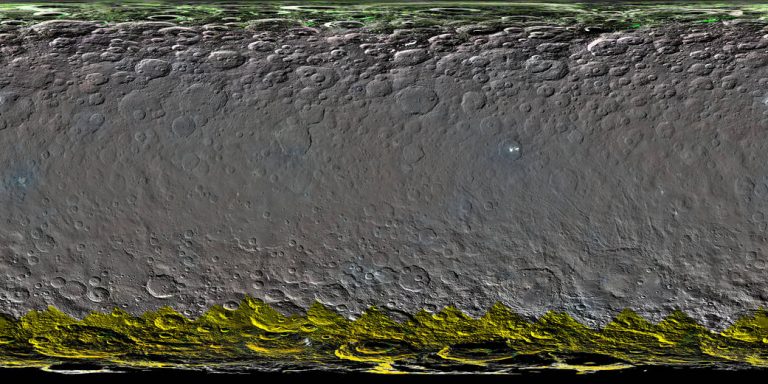The mysterious bright ‘alien’ spots on Ceres, like you’ve never seen them before

After orbiting the dwarf planet for about a year, the NASA’s Dawn spacecraft has surprised scientists with a set of the most detailed and closest images of the mysterious bright spots on the dwarf planet surface filled with astronomical mysteries. Taken from a distance of just 385 km away from the crater Occator, the images show complex features suggesting recent geological activity on Ceres who has remained one of the most mysterious celestial bodies in our solar system ever since the Dawn spacecraft started orbiting the dwarf planet.
On Tuesday, mission specialists released some of the closest views we have ever seen of the mysterious ‘alien’ world, harbouring huge and unexplained mountains, and mysterious bright spots that go odd randomly throughout the day.
In the new images from the Dawns spacecraft, we can observe at the center of the Occator crater a pit of around four kilometers in depth and a dome marked with mysterious fractures and other linear features which extend around it, adding to the mystery of the Dwarf planet.
“Before Dawn began its intensive observations of Ceres last year, Occator Crater looked to be one large bright area. Now, with the latest close views, we can see complex features that provide new mysteries to investigate. The intricate geometry of the crater interior suggests geologic activity in the recent past, but we will need to complete detailed geologic mapping of the crater in order to test hypotheses about its formation,” said Ralf Jaumann, planetary scientist, and Dawn co-investigator at the German Aerospace Center (DLR) in Berlin.
“Although impact processes dominate the surface geology on Ceres, we have identified specific color variations on the surface indicating material alterations that are due to a complex interaction of the impact process and the subsurface composition,” Jaumann said. “Additionally, this gives evidence for a subsurface layer enriched in ice and volatiles.”
According to researchers, additional data collected by the Dawn spacecraft revealed evidence supporting the presence of subsurface ice. This was corroborated by the Gamma-Ray Detector and Neutron probe, which found fewer neutrons in areas near the poles. This variation means higher hydrogen concentration near the poles, which in turn results in the possible presence of water ice in these areas.
“Our analyses will test a longstanding prediction that water ice can survive just beneath Ceres’ cold, high-latitude surface for billions of years,” said Tom Prettyman, the lead for GRaND and Dawn co-investigator at the Planetary Science Institute, Tucson, Arizona.
A week ago, researchers discovered that the mysterious bright lights on Ceres brighten and fade randomly during the day. According to observations made by ESO’s La Silla Observatory in Chile, after studying the enigmatic bright spots that have caused confusion among astronomers ever since their discovery, the team noticed a series of changes which occur as Ceres rotates. The spots appear to brighten during the day and showed other variations that have caused confusion among astronomers.
Ceres remains as one of the most studied objects in our solar system filled with unexplainable features such as the enigmatic bright spots and the Pyramidal shaped structure located in the middle where mountainous regions should not exist on the dwarf planet.
In the past, astronomers have speculated that numerous features on the dwarf planet are unlike anything they had ever seen before.
New images are expected to shed more light on the mysterious characteristics of Ceres.
Reference



 Creators of mankind
Creators of mankind Description of “Tall white aliens”
Description of “Tall white aliens” Where they came from?
Where they came from? About hostile civilizations
About hostile civilizations The war for the Earth
The war for the Earth “Tall white aliens” about eternal life
“Tall white aliens” about eternal life Video: “Nordic aliens”
Video: “Nordic aliens” Aliens
Aliens Alien encounters
Alien encounters The aliens base
The aliens base UFO
UFO Technology UFO
Technology UFO Underground civilization
Underground civilization Ancient alien artifacts
Ancient alien artifacts Military and UFO
Military and UFO Mysteries and hypotheses
Mysteries and hypotheses Scientific facts
Scientific facts


















